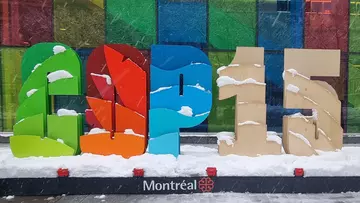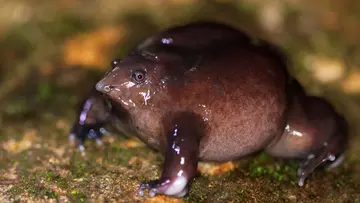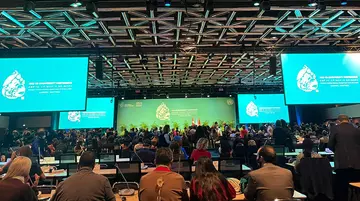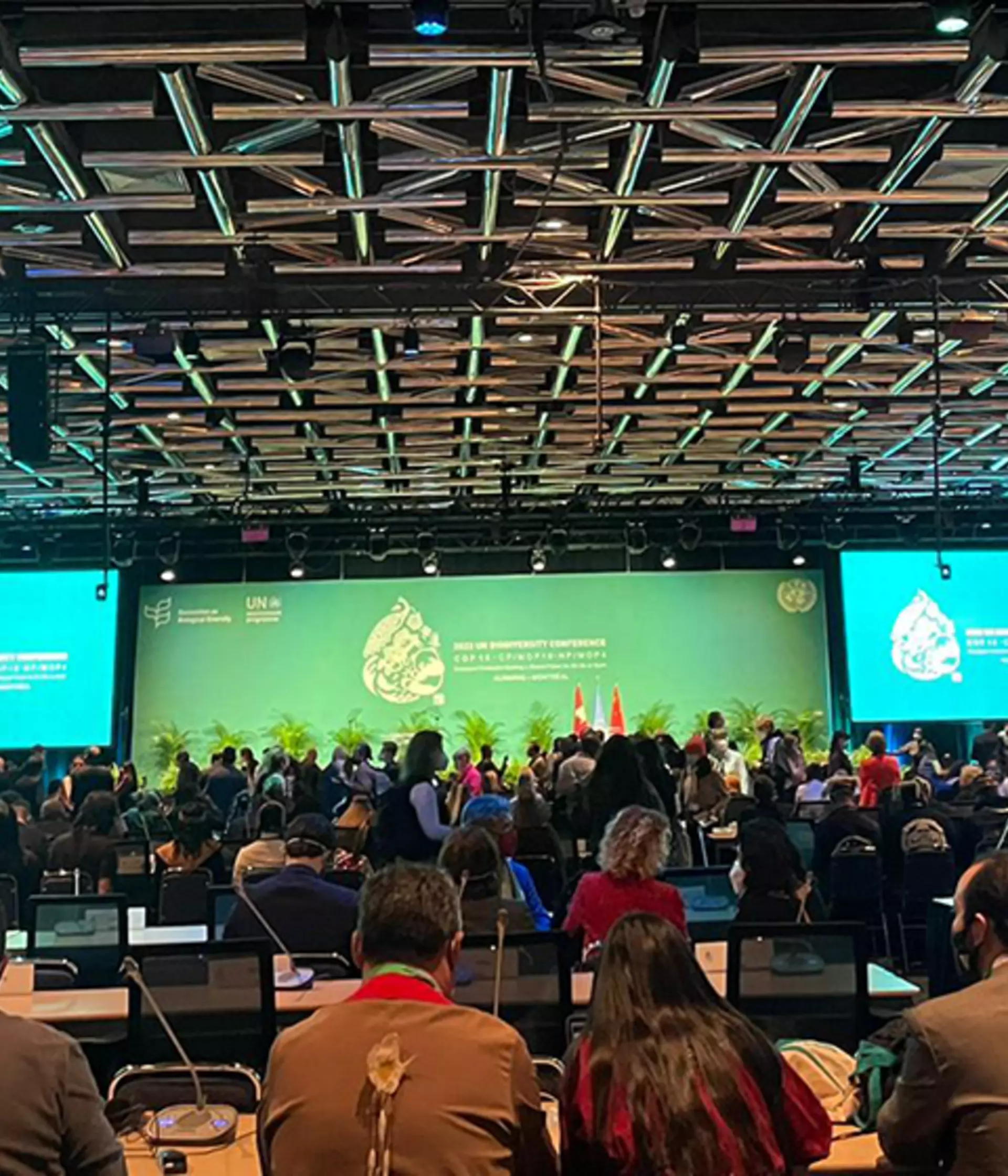
Bethan Laughlin
Senior Policy Specialist
Senior Policy Specialist, Bethan Laughlin, reflects on progress – or lack of – made so far at the Convention on Biological Diversity conference (COP15).

It's past the midway point of COP15 here in Montreal, yet it feels like there is one phrase permeating every side event, pavilion and negotiating hall: “we are not moving fast enough”.
At this vital negotiation, this line rings true in a range of ways. Firstly, global action on addressing the biodiversity crisis is moving far too slowly to address the scale of the issue – with ZSL’s Living Planet Index showing animal populations declining by an average of 69% between 1970 – 2018. Just as strikingly, here at COP15, the task of negotiating a global agreement on biodiversity – known as the Global Biodiversity Framework (GBF) - is also moving at a snail’s pace with the negotiations progressing painfully slowly.
A ”Clean” Global Biodiversity Framework
Lengthy and highly technical negotiations are not uncommon in UN spaces, but after Covid saw the delay of these negotiations on the GBF for over two years, the lack of progress thus far is becoming something of a sore point for negotiators and observers alike.
Square brackets are at the heart of the slow rate of progress in negotiating the GBF here at COP15. Anything within [square brackets] denotes that consensus has not been found on that text between negotiating parties, and in the realm of United Nations negotiations “consensus is king” and central to any successful agreement. A key problem facing negotiators this COP is the vast number of brackets that must be worked through to reach consensus. The Open-Ended Working Group (OEWG), a technical meeting that took place before the start of the formal COP, was tasked with taking the draft GBF and making it as “clean” as possible – aka, eliminating as many points of disagreement as possible. At the start of the week the GBF text contained over 900 square brackets, and by the end that had ballooned to over 1400 – not exactly the streamlining exercise that people had hoped for.
With this lack of progress on streamlining the text at the OEWG, COP15 negotiators also inherited the challenge of “cleaning” the GBF text, ready for government ministers to debate, and hopefully come to agreement on, later this week at the high-level segment. However, progress has been very slow, with hundreds of brackets remaining that must be resolved across the 22 targets, 4 goals and 8 sections of the GBF. Despite rest days being cancelled and additional sessions scheduled in an attempt to speed things along, as ministers arrive to begin the high-level negotiations on the key political areas of the GBF the text is still far from “clean”.
As a chair of a meeting stated on day 8 of negotiations: "It’s a day and a half until ministers arrive and we don’t have a GBF as it stands" – the blunt language here along with the number of brackets still to be discussed shows the scale of the task at hand.
ZSL’s Work at COP15
The ZSL team here at COP15 have been working closely with colleagues in BirdLife/RSPB, plus the delegations of IUCN, WWF, and others, to mutually reinforce united messaging on species ambitions, and other topics central to a successful GBF with Parties. This has included meetings and discussions with parties along with the sharing of scientific and technical advice.
The ZSL delegation has been pushing for three key components to be included in the GBF for the protection of species worldwide - halting extinctions, reducing extinction risk and increasing abundance. So far it is looking positive that these three areas will be retained in the GBF – but the ambition and timelines for each are still unclear and there is concern that ambition could be reduced.
Several parties have been pushing for extinctions to be halted from now – noting that this is what parties agreed to do back in 2010 within the Aichi targets – but others have pushed for by 2030 or even later, delaying previously agreed ambition by 10 years. There also remains much disagreement on the aspirations for reducing extinction risk and increasing abundance, both by 2030 and 2050 - we will see within the coming days how ambitious the targets being set are.
Target Four of the Global Biodiversity framework, which relates to species conservation, is looking relatively free of brackets and is a strong target for the recognising the need for urgent species recovery. However, several key topics - including Goal A which covers actions for protecting ecosystems, species and genetic diversity – are still up for debate over the coming days.
Alongside the technicalities of the negotiations, ZSL has also been participating in a range of side events. A dedicated session was held with colleagues from RSPB and On the EDGE during the opening day of COP15, focusing on evidence-based biodiversity measurements including the Living Planet Index and Red List Index. An alliance was also launched with organisations working to conserve EDGE species - evolutionarily unique species, such as pangolins, purple frogs and red pandas – which has already announced funding opportunities to support the development of protected sites for these distinct species.

The Need for Rights-Based Conservation
The vital role of Indigenous peoples and local communities (IPLC’s) has also been a major area of discussion, but time will tell if it translates into strong protections within the GBF.
IPLCs account for less than 5% of the world population but their lands safeguard 85% of earth’s remaining Biodiversity areas. As such, for a global agreement on biodiversity like the GBF the roles, expertise and rights of Indigenous peoples need to be safeguarded as integral stewards of biodiversity world-wide.
Additionally, vital discussions are ongoing on how the commitments to the protection of 30% of land and sea for nature by 2030 can also ensure a rights-based approach for IPLC’s and embrace the need for free, prior and informed consent to be at the centre of engagement with Indigenous peoples and local communities.
IPLC groups and representatives are pushing for the right to a place at the decision-making table alongside active participation in all stages implementing the GBF. Central to a successful COP15
decision will be how the resource mobilisation for the implementation of the GBF can include ways for increasing the number of funds and resources going directly to IPLC’s.

The Final Days of COP15
The reality is, with under a week left of the negotiations there is still a huge amount to play for within the makeup of the Global Biodiversity Framework, including the vital question of how goals set by the framework will be funded and how developing countries will be supported – a contentious topic which has already seen delegates walk out of negotiations due to the scale of disagreement. Progress towards setting ambitious targets to protect nature will have to move quickly over the coming days if we are going to get the breakthrough deal the world needs to safeguard nature.
COP 27, followed by COP 19 in Panama in November and COP15 in Montreal in December, will together put a much-needed spotlight on the decline in global biodiversity.
But without coordinated nature-based policies in place across the world, animals will continue to go extinct, ecosystems will continue to break down and climate change will continue to change life on earth as we know it.
It is vital that governments commit to using nature-based solutions - rooted in science from ZSL and organisations like it - to tackle the combined threats of climate change, biodiversity loss and public health crises.
It is with science that those in power must start: throughout conference season, ZSL is calling for world leaders to put nature at the heart of all global decision-making to better protect ecosystems, wildlife and the communities who rely on them.
Support ZSL's global science and conservation work and find out more
Climate change and human activity have pushed our precious planet to its limit, causing the devastating loss of so many habitats and species. From lab to field, hands on and behind the scenes, we’re leading the future of conservation, shaping agendas and influencing change to support better life, health and living for people and wildlife.
